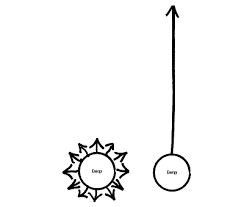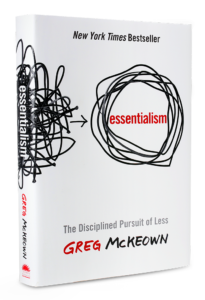I generally don’t review books about productivity, self-improvement or origami in this space, mostly because they are crap or repetitive or repetitively crappy and they don’t work (especially the origami books). Today is an exception and that’s because Greg McKeown’s 2014 book, Essentialism, has some awfully good lessons for marketers.
His premise isn’t really new: stop doing stuff that doesn’t matter and start doing stuff that does matter. What’s different is the very direct approach to choosing the problem you want to solve and saying no to everything that doesn’t directly help you do that.
We’ve looked before at the importance of using our marketing calories (energy) in the right places versus the time-wastey ones, and this is how McKeown approaches it: Less but better.
Can marketers do less and get better results? I think so:
I have this illustration scribbled on white boards and inside covers of notebooks all over the place lately. If you share my goldfish-like attention span and a seemingly bottomless to do list, this little drawing is for you.

If you can’t make it out, the premise is that most of us spend our energy doing a bunch of things, each of which we move a tiny bit along. Essentialists spend the same amount of energy doing one thing and actually getting someplace.
This is probably one of the few books like this that I’ve actually read twice. Once in a single go on a camping trip, and again in bits and pieces over the past month. It’s an easy read and treads a bit of familiar territory, though with a new spin, and lots of examples from real businesses. He even takes on those cat puke corporate values:
I recently spent some time with the CEO of a company in Silicon Valuly valued at $40 billion. He shared with me the value statement of his organization –
“We value passion, innovation, execution, and leadership.” One of several problems with this list is, Who doesn’t value these things? Another problem is
that this tells employees nothing about what the company values most. It says nothing about what choices employees should be making when these values are at odds.
Trade-offs are a big part of the essentialist’s toolkit for coping. This can include bouncing meaningless twaddle from the corporate values or simply electing not to do a project, launch a product, tackle an issue or join a fun committee.
Here are the other lessons for marketers that I jotted down:
- Almost everything is noise – find the signal
- We forget that we can choose (or not) just about anything
- Trade-offs are everywhere: go big on something
- Create space for your team to stop going to meetings and actually think about how they will solve things

- Read
- Get out in the field
- Clearly understand the question you are trying to answer
- Play – when was the last time you and your colleagues played (hiding someone’s Lean Cuisine does not count)
- In any decision, options you rate lower than 9 out of 10, just rate zero and stop thinking about them
- Say no firmly, resolutely, gracefully (I’ve been practicing this lately, and I can tell you there is a bonus when you do it right – the other person’s head still explodes but very, very quietly)
- Is your marketing automation stack a piece of sh*t? Agency not delivering? Look past sunk costs and consider the time and money you’ll gain if you just get rid of them. This is a big one for marketers. I can’t count the number of terrible strategies and campaigns I’ve watched limp along for ages because they were so expensive to put together.
- Use zero-based budgeting for both your time and your spend. We’ll dig into that one another time – here is a link to a good explanation http://www.accountingtools.com/zero-based-budgeting
- Try a reverse pilot: test what happens if you remove something from a product or service.
- Build great fences to keep non-marketing problems out of the marketing department
- Focus on removing constraints and not increasing productivity
- Understand what is important now. Revenue? Brand? Share? New product launch? Hiring? Competitive strategy? Go do that.
If you are looking for an exemplar, I might suggest you wander along the corridor to the sales department. Good sales leaders understand essentialism, and work hard to keep their Squirrels focused on one set of nuts at a time.
If you do nothing else today, print off that image above and tape it on your white board. The next time you are filling the board with your to do list, or mapping out the hundreds of things you need to deliver next year, ask which side of the picture you are really on.
I would like to tell you that McKeown’s website is chock full of helpful resources and tools, but it really isn’t. He has a badly out-of-date blog, a lot of ways to purchase the book and his upcoming speaking engagements. He really needs to focus more…
Related Posts
Put that Marketing Plan Where the Sun Doesn’t Shine
Four Simple Steps for Planning for Marketing Doom
BizMarketer is written by Elizabeth Williams
I help companies have better conversations
Drop me a line at ewilliams@candlerchase.com
Or follow me @bizmkter
Great article, also checkout Greg McKeown’s interview on the AoC Podcast, he gives a lot of tips about this, it’s been really helpful for me.